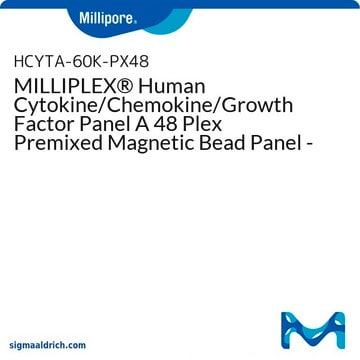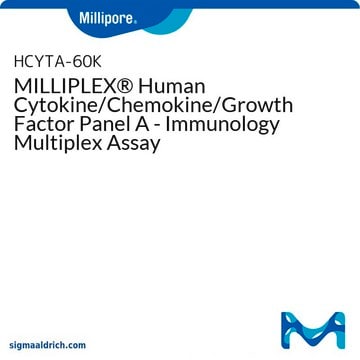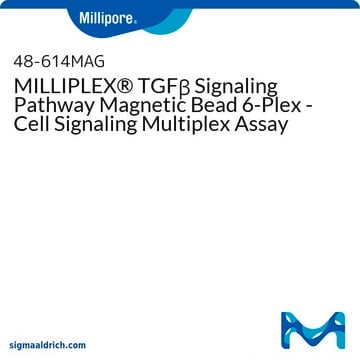TGFBMAG-64K-03
MILLIPLEX® TGFß Magnetic Bead 3 Plex Kit - Immunology Multiplex Assay
for quantification of TGFß1, TGFß2 and TGFß3 in multiple species
Synonym(e):
3 Plex TGFß Assay, TGFß Magnetic Bead Kit
About This Item
Empfohlene Produkte
Qualitätsniveau
Speziesreaktivität
horse, human, nonhuman primates, feline, pig, mouse, rat, canine
Hersteller/Markenname
Milliplex®
assay range
accuracy: 62-128%
sensitivity: 8-12 pg/mL
standard curve range: 9.8-2,500 pg/mL
Methode(n)
multiplexing: suitable
Kompatibilität
configured for Premixed
Nachweisverfahren
fluorometric (Luminex xMAP)
Versandbedingung
wet ice
Allgemeine Beschreibung
The MILLIPLEX® TGFβ 1, 2 and 3 Panel is a 3-plex kit to be used for the simultaneous quantification of the following analytes in serum, plasma and cell/tissue culture samples: TGFβ1, TGFβ2, TGFβ3. The Luminex® xMAP® platform uses a magnetic bead immunoassay format for ideal speed and sensitivity to quantitate multiple analytes simultaneously, dramatically improving productivity while conserving valuable sample volume.
Panel Type: Cytokines/Chemokines
Anwendung
- Analytes: TGF-β1, TGF-β2, TGF-β3
- Recommended Species: In addition to human, TGF-β1, TGF-β2, TGF-β3 can be detected in the serum of the following species: mouse, rat, mini pig, hamster, guinea pig, rhesus monkey and cynomolgus monkey samples. Additionally, TGF-β1 and TGF-β2 can be detected in the serum of horse, rabbit and canine. However, the exact amount of cross reactivity has not been determined.
- NOTE: This assay requires a sample acidification treatment using the provided reagents and protocol.
- Recommended Sample Types: Serum, plasma, cell/tissue culture supernatants and lysates
- Recommended Sample Dilution: 25 μL per well of a 1:30 dilution after acidification treatment of serum and plasma samples; cell/tissue culture samples may require dilution prior to acidification treatment (see protocol for details).
- Assay Run Time: Overnight (16-18 hours) at 2-8°C or alternatively, 2 hours at room temperature (20-25°C).
- Research Category: Inflammation & Immunology
- Research Subcategory: Cardiovascular Disease, Chronic Inflammatory Disease, Immune Disorders, Inflammatory Disease, Rheumatoid Arthritis
Rechtliche Hinweise
Signalwort
Danger
H-Sätze
Gefahreneinstufungen
Aquatic Chronic 2 - Eye Dam. 1 - Met. Corr. 1 - Skin Corr. 1A - Skin Sens. 1
Lagerklassenschlüssel
8A - Combustible corrosive hazardous materials
WGK
WGK 3
Analysenzertifikate (COA)
Suchen Sie nach Analysenzertifikate (COA), indem Sie die Lot-/Chargennummer des Produkts eingeben. Lot- und Chargennummern sind auf dem Produktetikett hinter den Wörtern ‘Lot’ oder ‘Batch’ (Lot oder Charge) zu finden.
Besitzen Sie dieses Produkt bereits?
In der Dokumentenbibliothek finden Sie die Dokumentation zu den Produkten, die Sie kürzlich erworben haben.
Verwandter Inhalt
Discover benefits of using biomarker detection multiplex immunoassays for companion and agricultural animal health research and find vet med multiplex assays.
Learn how immunoassays are used in cosmetics and personal care research to discover potential harmful effects of cosmetics products, and assess markers of inflammation, sensitization, aging, and tissue regeneration among others.
See how multiplexing the inflammation signaling pathway with MILLIPLEX® inflammation assays or cell signaling assays can help researchers bridge the gap between immunology and cell signaling, including investigating T cell signaling, Th Cell differentiation, inflammatory response signaling, and sepsis signaling.
Uncover tips and tricks to multiplexing in this guide from the experts. Learn how you can enhance the power of your research with MILLIPLEX® multiplexing, including industry guidance for immunoassays, multiplexing tips, one-day MILLIPLEX® multiplex assays for limited lab time, and more.
Active Filters
Unser Team von Wissenschaftlern verfügt über Erfahrung in allen Forschungsbereichen einschließlich Life Science, Materialwissenschaften, chemischer Synthese, Chromatographie, Analytik und vielen mehr..
Setzen Sie sich mit dem technischen Dienst in Verbindung.








